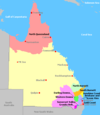Tasmania and Queensland Flashcards
Queensland
Official and Unofficial Gi’s

(clockwise from 1:00)
- South Burnett GI - est 2000
- Sunshine Coast & Hinterlands
- Brisbane & Scenic Rim
- Gold Coast & Hinterlands
- Granite Belt GI - est 2002
- Darling Downs

Granite Belt
Climate and Natural Features
Climate:
- Subtropical, but very high altitude (700 M+)
- Fraught with spring frosts and rain at harvest
Natural Features:
- Great Dividing Range
- Granite Belt (200 year old granitic intrusion, running down into New England Australia, sometimes called the New England Tableland)
South Burnett
Climate and Natural Features

Climate:
- Subtropical and continental, with more growing season rainfall than any other continental climate in the country
Natural Features:
- Burnett River (N)
- Blackbutt, Brisbane, and Coast Ranges (E)
- Great Dividing Range (S)

What is Australia’s coolest growing region?

Tasmania

What is Tasmania’s most notable product?

traditional method sparkling wine

Northern Tasmania Unofficial Subzones
(W to E)
- North West Coast
-
Tamar Valley
- generally achieves ripeness earlier, making it more suitable for late ripening varieties
-
Pipers River
- within Tamar, better for earliy ripening varieties

Where is Jansz?; who founded it?; who owns it now?
- Jansz is in Pipers River (N Tasmania)
- Founded as a collaboration between Heemskerk (Tassie) and Louis Roederer
- Now owned by Hill-Smith Family Vineyards (Yalumba)
Southern Tasmania Unofficial Subzones
(W to E)
- Huon Valley
- Derwent Valley
- Coal River / Richmond (longer sunlight hours, can ripen later maturing varieties)
- East Coast

What major European wine regions can Tasmania be compared to?

Champagne and Rheingau

Queensland: 2 Regions
Granite Belt (1965)
South Burnett (1993)
This unofficial region of Queensland is posed to the be third GI:
Darling Downs
- south of South Burnett GI
Does Queensland have any zones?
No
Producers of the Granite Belt GI:

Robert Channon
Boireann
Ballandean Estate
Grapes of the Granite Belt GI?
(63%) Shiraz, CS, Merlot
(37%) Chardonnay
Soil of South Burnett GI?
Basalt and Granite
Grapes of South Burnett GI?
(68%) Shiraz, Merlot
(32%) Verdelho, Semillon, Chardonnay
Geographical Features of South Burnett GI:
Blackbult, Brisbane, Coast Ranges
Great Dividing Range
Brunett River
Tasmania’s Sole Appellation:
Tasmania GI
What separates Tasmania from mainland?
Bass Strait
Where is Piper’s River GI located?

Northern Tasmania
Most important region of Southern Tasmania?
Coal River
Most-planted red variety of Tasmania?
Pinot Noir
42%
Most-important sparkling producer?
Jansz
- originally a project between Louis Roederer and Heemsherk Wines
* oldest commercial producer of sparkling
Unofficial sub-regions of Northern Tasmania?

Piper’s River
Tamar Valley
North West Coast












